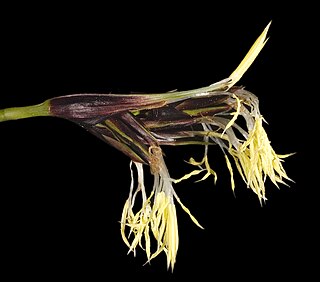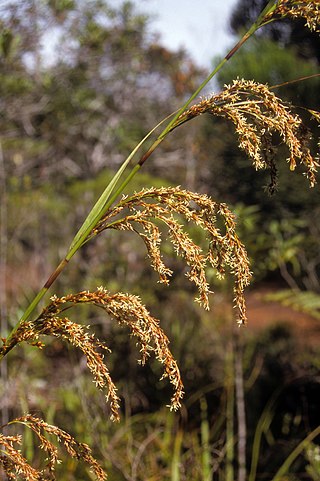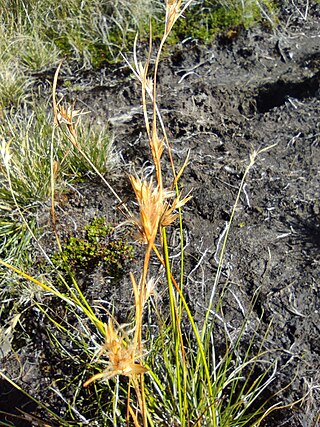
The Cyperaceae are a family of graminoid (grass-like), monocotyledonous flowering plants known as sedges. The family is large: botanists have described some 5,500 known species in about 90 genera, the largest being the "true sedges" with over 2,000 species.
Mapania is a genus of plants in the family Cyperaceae. It contains 100 species, distributed in tropical regions of Africa, India, southern China, Southeast Asia, New Guinea, Australia, Central America, northern South America, and various oceanic islands.

Lepidosperma is a genus of flowering plant of the family Cyperaceae. Most of the species are endemic to Australia, with others native to southern China, southeast Asia, New Guinea, New Caledonia and New Zealand.

Kobresia is a genus of plants in the sedge family. They are sometimes called bog sedges. These perennial sedges are quite similar to Carex species in appearance. The genus is widespread across much of Europe, Asia and North America, with many species native to the Himalayas.

Schoenus is a predominately austral genus of sedges, commonly known as bogrushes, or veldrushes in South Africa. Species of this genus occur mainly in South Africa, Australia and Southeast Asia. Others are found in scattered locations worldwide, from Europe to Asia, North Africa and the Americas. Three species occur in the peatlands of southern South America, including S. antarcticus which is found in Tierra del Fuego, where it forms a component of hyperhumid Magellanic moorland.

Trichophorum is a genus of flowering plants in the sedge family, Cyperaceae. Plants in this genus are known as deergrasses in Britain but are sometimes known as bulrushes in North America.

Machaerina (twigrush) is a genus of flowering plants in the sedge family. Its species occur in tropical America, the West Indies, Malesia, Australia and the Pacific region. The name comes from the Greek machaira, alluding to the shape of the leaves in the type species – Machaerina restioides.

Tetraria is a genus of flowering plants in the sedge family, Cyperaceae, native to Tanzania, South Africa, Borneo, Australia and New Zealand.

Costularia is a plant genus in the family Cyperaceae. It includes 15 species native to southeastern Africa, ranging from South Africa through Eswatini, Mozambique, Zimbabwe, and Malawi, and to the islands Madagascar, Réunion, and the Seychelles in the Western Indian Ocean.

Carpha is a genus of flowering plants belonging to the family Cyperaceae.
Lagenocarpus is a genus of flowering plants belonging to the family Cyperaceae.
Cyperus albopilosus is a species of sedge that is native to an area of Africa.
Cyperus phillipsiae is a species of sedge that is native to eastern parts of Africa.
Cyperus pseudovestitus is a species of sedge that is native to parts of Africa.
Cyperus remotus is a species of sedge that is native to parts of Africa.








